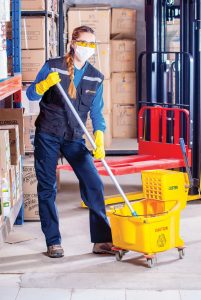— By Matt Brown —
Considerations for a successful return to growth for restaurants and retailers.
When the COVID-19 pandemic sent everyone into their homes in March, businesses had to make fundamental changes to their operations. The restaurant industry “doubled-down” on takeout and delivery services, and essential retailers worked around the clock to clean and sanitize the store and restock in-demand items. Meanwhile, some restaurants and non-essential retailers were forced to close, hoping for the opportunity to reopen their doors sooner rather than later.

Matt Brown, Vixxo
Any way you slice it, when the time comes to emerge from our homes, customers will once again seek out the in-person experiences they once cherished. And that will require businesses to reestablish trust with customers — and employees — still leery of spreading the virus or getting sick themselves.
As we continue to monitor the health of the people in our communities, businesses will need to remain flexible and understand the changes required to reopen responsibly. For example, Starbucks recently shared how they will approach this transition by adjusting to new customer expectations and evolving the Starbucks experience.
Diligence and Visible Changes Will Help Build Trust
It’s not enough to put out a message saying, “We’re open again for business.” Instead, consumers will look for visual cues that added precautions are in place to prevent future spread of the virus. Retailers and restaurateurs will need to show employees and consumers that they planned for and prioritized their well-being, even while closed. This includes the important steps necessary to ensure a clean, sanitized environment as well as being prepared to maintain some “comfort” distancing among patrons — for the long term.
 Whether your location was exposed to the virus or not, here are ways to provide extra assurances to customers and employees that you are making changes with their best interests in mind:
Whether your location was exposed to the virus or not, here are ways to provide extra assurances to customers and employees that you are making changes with their best interests in mind:
- Regularly sanitize your location. Work from the back of the house, and move to the front of the house. For retailers, start at the loading dock and move to the front. For restaurants, begin at the kitchen and move to the dining area, front entrance, then outside the building. Both should focus on high-touch, highdemand areas like door handles and credit card readers and outdoor assets like coolers, RedBox kiosks and propane tanks.
- Implement new cleaning rigors. Increase daily cleaning rituals. Non-toxic, non-corrosive and FDA/EPA-approved virus-killing sanitizers should be applied to all high-touch areas and surfaces. For areas like bathrooms, more frequent cleanings will be needed.
- Abide by new CDC regulations. The CDC has suggested changes around air filtration and HVAC systems. Adjust the amount of fresh air circulating through your facility, and make sure to change filters more frequently and replace them with higher MERV filters to trap any potential airborne contaminants.
- Prioritize employee hygiene. Make sure employees understand the role they can play to help stop future spread of the virus by practicing more stringent hygiene. Regular handwashing and use of hand sanitizer or gloves should continue to be used in the workplace.
- Rearrange seating and queuing areas. Ongoing precautions and social distancing guidelines may require more separation between patrons, in both dining as well as checkout areas — not to mention it may make customers feel more comfortable. Plan accordingly to ensure increased spacing between customers.
- Understand what matters to customers now. For example, will customers demand contactless payment options? How will self-service areas work (for example, food and self-checkout)? Will diners still be allowed to select their own utensils? And will you need to install sneeze guards at order and pay stations?
Then, communicate with confidence that the facility is continuously disinfected from top to bottom as we navigate back into normal life.
Hitting Restart
 In addition, for retailers and restaurants that are looking to reopen, additional consideration should be given to equipment that had been sitting idle. Bring staff in early to thoroughly test the equipment and make sure it is ready to support your customers. A false start where equipment fails will create trust issues for even the most loyal customers. Bring in the professionals if necessary to make sure all assets are operating at 100% productivity.
In addition, for retailers and restaurants that are looking to reopen, additional consideration should be given to equipment that had been sitting idle. Bring staff in early to thoroughly test the equipment and make sure it is ready to support your customers. A false start where equipment fails will create trust issues for even the most loyal customers. Bring in the professionals if necessary to make sure all assets are operating at 100% productivity.
It’s All About the Experience
At the end of the day, the experience will still remain the defining factor for consumer loyalty. While the thresholds may have shifted slightly, the building blocks for great experiences will continue to be value, atmosphere (which includes cleanliness), convenience and staff.
 As restrictions begin to ease, consumers will return to retailers and restaurants that they believe will provide them with best value and experience. But seemingly minor problems can derail that trust. For example, if the sign outside the building won’t stay lit, if a “broken” sign is taped to the door, if facilities look dirty and rundown — a guest will notice and downgrade their impressions. By focusing on the basics, like clean and well-maintained facilities, and providing good value to customers, businesses can rebuild that trust they once took for granted.
As restrictions begin to ease, consumers will return to retailers and restaurants that they believe will provide them with best value and experience. But seemingly minor problems can derail that trust. For example, if the sign outside the building won’t stay lit, if a “broken” sign is taped to the door, if facilities look dirty and rundown — a guest will notice and downgrade their impressions. By focusing on the basics, like clean and well-maintained facilities, and providing good value to customers, businesses can rebuild that trust they once took for granted.
Now is the time to zero-in on everything that affects the facility — from cleanliness to properly functioning equipment and lighting — and contributes to a better customer experience. These factors, combined with a business’ response to the pandemic and the trust it builds with employees and customers, will play an important role in its future success.
— Matt Brown is chief revenue officer at Vixxo, a leading facilities management partner for many Fortune 500 clients in the restaurant, retail, convenience and supermarket industries. This article originally appeared in the May 2020 issue of Retail & Restaurant Facility Business magazine.
